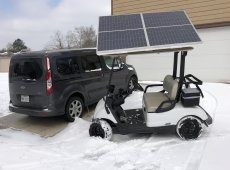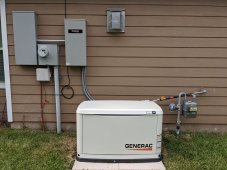Hello,
I would like to get the group's input on a solar installation. I am completely new to solar. My goal is not to save money, or get entirely off of the grid just yet.
I simply want to be able to limp along during potential long-term power outages. Speaking of long, this is a long post. But I wanted to give everyone as much background as possible. Thanks for bearing with me.
I am of limited funds. So I am putting together small subsystems based on priority, adding them as money allows.
I plan to select components for each system from the same vendor for interchangeability. Solar is plentiful, limited only by crappy Ohio weather. I have diversified my emergency preparations and I can go without power if absolutely necessary. So I don't need to oversize it just yet. That comes later.
I can set up each system with a very short run. I plan to put them in secure housings attached to the outside of my home, one on the north, one on the south, and one on my garage.
I have two sources of heat. I have plenty of food, but I will need to keep it cold and prepare meals. But I will ask that question in another post as it is priority #2.
First, I want to take care of water and sanitation. I'm on bored well and septic so I am in good shape there. My well pump is ideally placed for solar. It sits on the north side of our house and gets plentiful sun. I want to put together a system that is capable of powering the pump, take short showers (cold water is a heck of a motivator), and an occasional use of the washing machine on its lowest setting (also without hot water).
I need 35 amp hours to keep water flowing, based on the pump specs and the cycle time. I have a 10 gallon bladder that I can pressure bleed to flush toilets overnight. This is a guesstimate as I have not measured the actual load, nor my wife's flush frequency.
I need approximately 35 amp hours to run the washing machine on a short duty cycle. Again, this is based on specifications and cycle times. But if you think my calculations are way off, please let me know.
I want to size a system that will always keep my water running. I've bailed buckets from my pond to flush the toilets. That was no fun. The pump requires 750 watts with a 2000 watt surge.
And I would rather not have to use a washboard to do laundry in my pond. My washing machine requires 1100 watts with a 2200 watt surge. Mine is a 2 person household and I will likely buy a smaller washing machine in the near future.
I will ask about a second system for food storage and preparation in another post.
Thanks in advance for your help!
Scott
I would like to get the group's input on a solar installation. I am completely new to solar. My goal is not to save money, or get entirely off of the grid just yet.
I simply want to be able to limp along during potential long-term power outages. Speaking of long, this is a long post. But I wanted to give everyone as much background as possible. Thanks for bearing with me.
I am of limited funds. So I am putting together small subsystems based on priority, adding them as money allows.
I plan to select components for each system from the same vendor for interchangeability. Solar is plentiful, limited only by crappy Ohio weather. I have diversified my emergency preparations and I can go without power if absolutely necessary. So I don't need to oversize it just yet. That comes later.
I can set up each system with a very short run. I plan to put them in secure housings attached to the outside of my home, one on the north, one on the south, and one on my garage.
I have two sources of heat. I have plenty of food, but I will need to keep it cold and prepare meals. But I will ask that question in another post as it is priority #2.
First, I want to take care of water and sanitation. I'm on bored well and septic so I am in good shape there. My well pump is ideally placed for solar. It sits on the north side of our house and gets plentiful sun. I want to put together a system that is capable of powering the pump, take short showers (cold water is a heck of a motivator), and an occasional use of the washing machine on its lowest setting (also without hot water).
I need 35 amp hours to keep water flowing, based on the pump specs and the cycle time. I have a 10 gallon bladder that I can pressure bleed to flush toilets overnight. This is a guesstimate as I have not measured the actual load, nor my wife's flush frequency.
I need approximately 35 amp hours to run the washing machine on a short duty cycle. Again, this is based on specifications and cycle times. But if you think my calculations are way off, please let me know.
I want to size a system that will always keep my water running. I've bailed buckets from my pond to flush the toilets. That was no fun. The pump requires 750 watts with a 2000 watt surge.
And I would rather not have to use a washboard to do laundry in my pond. My washing machine requires 1100 watts with a 2200 watt surge. Mine is a 2 person household and I will likely buy a smaller washing machine in the near future.
I will ask about a second system for food storage and preparation in another post.
Thanks in advance for your help!
Scott




